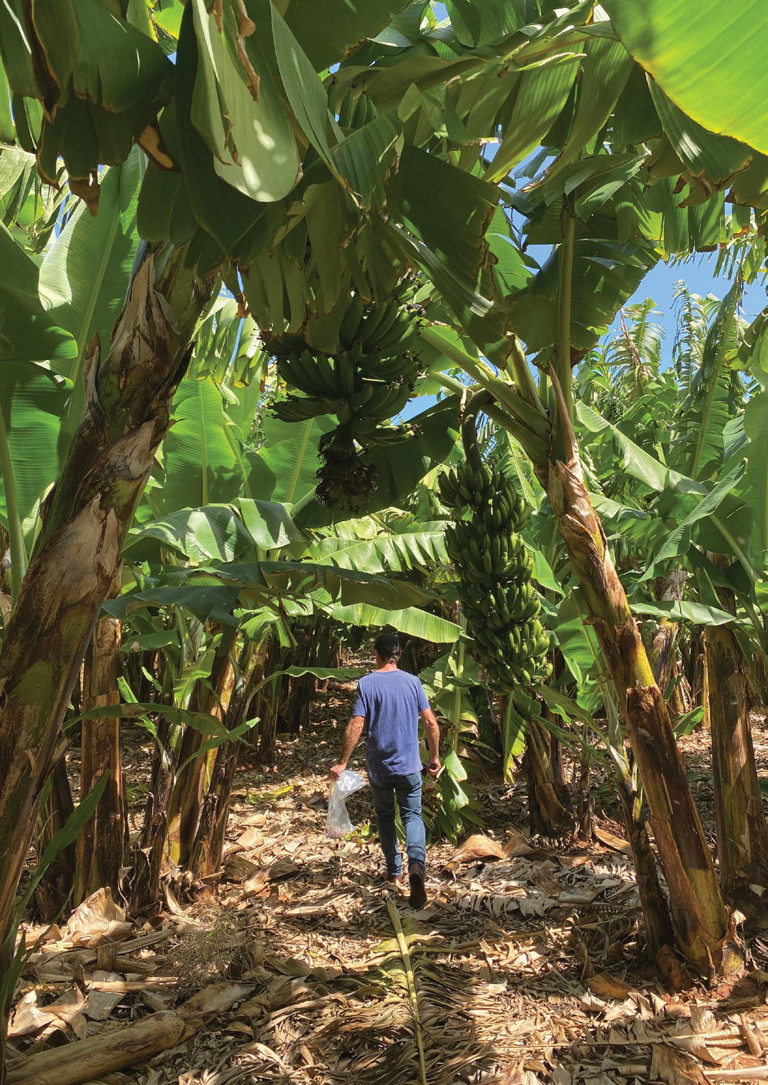
CARNARVON
Agronomist Scott Brain walks through a Biomineral banana plantation, taking soil samples to monitor the soil health of the crop.
Magic
microbes

BY MICHAEL BARTHOLOMEW
OUTGOING REGIONAL
DEVELOPMENT OFFICER,
VEGETABLESWA
What can a switch to the Biomineral System achieve?
We chat to growers who have made the change.
We have previously discussed the Biomineral System broadly as a system of production that can bolt on to existing production systems to increase their efficiency and sustainability.
Despite our headline, it’s nothing magic. It’s just a specific blend of microbes and altered agronomic practises that make a large difference to the quality and costs associated with growing produce.
By adding microbes to the soil and feeding not only the plants with fertiliser, but also the microbes, the soil becomes more than just a substrate or growing medium – it becomes a complex (and helpful) ecosystem in its own right.
Some of the microbes work to extend the plant’s root system, some work to fix nitrogen from the atmosphere and some work to break down inaccessible nutrients into plant-available forms. The end result is vastly increased fertiliser and water-use efficiency and a consistently higher quality crop. Given the current cost-price squeeze impacting horticultural production, the Biomineral System is increasing in popularity.

AN eggplant under the Biomineral System.
“ The end result is vastly increased fertiliser and water-use efficiency and a consistently higher quality crop. Given the current costprice squeeze impacting horticultural production, the Biomineral System is increasing in popularity. ”
What do the growers think?
It’s not just about better quality produce. Everyone we have spoken to in WA who has used this system has had a different reason to like it. We interviewed five growers to find out more about their experiences with the Biomineral System and asked them to share their thoughts.
The growers interviewed were located as far north as Carnarvon and as far south as Donnybrook, and they grew a variety of crops (not just vegetables). Crops ranged from tomatoes to bananas, from apples to nectarines and pumpkins to eggplants. Soil types ranged from hungry sand to cracking clay and all the loams in between.
On average, the growers had more than 20 years of growing experience each, however their time using the Biomineral System was varied. Here’s the interview.
Q1: What made you begin this system of growing?
• Issues with failing soils following decades of conventional tillage and chemical applications.
• Expensive fertiliser inputs not being held within the soil.
• It had worked well in the veggie patch, so they wanted to expand it to bigger crops.
• Aneighbour began using it on their lawn and it was the best they’d seen it.
• Other growers spoke highly of it, so they started using the system out of curiosity.
What we liked about this question were the varied responses. Some growers wanted to use it as a last effort to increase productivity and some liked what they saw over the fence. When asked if they had any teething issues when moving to the Biomineral System, all growers agreed that it was an easy experience. Some growers indicated that they had to pay extra attention to the chemicals they used because they didn’t want to kill the microbes. Other growers even wanted to instinctively apply more fertiliser than required due to the stark differences in fertiliser requirements.
When asked the difference between the Biomineral System and conventional farming from a management perspective, most growers agreed that the Biomineral System was easier, with a few tweaks. Some growers highlighted that they needed to fertilise less, therefore store less fertiliser and that the ideal fertiliser application method had changed and was a more hands-off process.

BY adding microbes to the soil, it becomes more than just a substrate or growing medium – it
becomes a complex ecosystem in its own right.
Q2: What benefits have you noticed and which are more important to you?
• Fruit quality dramatically increased: a higher grade product with better taste, and higher water and brix.
• Better shelf life: fruit stores for far longer than that produced with conventional fertiliser.
• Soil health has dramatically improved: soils are more friable and hold water far better.
• Plants have better vigour and are able to withstand pests and disease better than before.
• Cost savings by using dramatically less fertiliser.
• Increased return per hectare resulting in needing to plant less and having more spare time.
“ ... reasons for adopting the system are wide and varied, however the most recurring feedback was the shelf life of the fruit being far better than that of conventionally grown produce. ”
All growers began using the system on a small scale before expanding to their entire farm. Generally they began using the system as a result of seeing the success of other growers. From the responses above, the reasons for adopting the system are wide and varied,however the most recurring feedback was the shelf life of the fruit being far better than that of conventionally grown produce. Additionally, the growers added that the first six months of using the system felt strange as they didn’t need to apply nearly as much fertiliser as they’re used to.
Fortunately, most of the growers knew of someone who had already made the switch and they were able to reassure them that it was going to work (initially it sounds rather unconventional).
If you would like to learn more about the Biomineral System and would like support navigating the early stages, we’re here to help. Please get in touch using the contact details below.
MORE INFORMATION
Contact Katrina Hill on 0427 373 037 or email katrina.hill@vegetableswa.com.au.